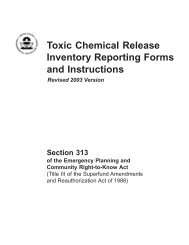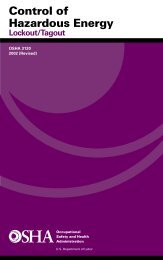Ergonomic Guidelines for Nursing Homes - Seton Resource Center
Ergonomic Guidelines for Nursing Homes - Seton Resource Center
Ergonomic Guidelines for Nursing Homes - Seton Resource Center
You also want an ePaper? Increase the reach of your titles
YUMPU automatically turns print PDFs into web optimized ePapers that Google loves.
Section II. A Process <strong>for</strong> Protecting Workers<br />
The number and severity of injuries resulting from physical demands in nursing<br />
homes—and associated costs—can be substantially reduced (2, 9). Providing an<br />
alternative to manual resident lifting is the primary goal of the ergonomics process in the<br />
nursing home setting and of these guidelines. OSHA recommends that manual lifting<br />
of residents be minimized in all cases and eliminated when feasible. OSHA further<br />
recommends that employers develop a process <strong>for</strong> systematically addressing ergonomics<br />
issues in their facilities, and incorporate this process into an overall program to recognize<br />
and prevent occupational safety and health hazards.<br />
An effective process should be tailored to the characteristics of the particular<br />
nursing home but OSHA generally recommends the following steps:<br />
Provide Management Support<br />
Strong support by management creates the best opportunity <strong>for</strong> success. OSHA<br />
recommends that employers develop clear goals, assign responsibilities to designated<br />
staff members to achieve those goals, provide necessary resources, and ensure that<br />
assigned responsibilities are fulfilled. Providing a safe and healthful workplace requires<br />
a sustained ef<strong>for</strong>t, allocation of resources and frequent follow-up that can only be<br />
achieved through the active support of management.<br />
Involve Employees<br />
Employees are a vital source of in<strong>for</strong>mation about hazards in their workplace.<br />
Their involvement adds problem-solving capabilities and hazard identification assistance,<br />
enhances worker motivation and job satisfaction, and leads to greater acceptance when<br />
changes are made in the workplace. Employees can:<br />
• submit suggestions or concerns;<br />
• discuss the workplace and work methods;<br />
• participate in the design of work, equipment, procedures, and training;<br />
• evaluate equipment;<br />
• respond to employee surveys;<br />
• participate in task groups with responsibility <strong>for</strong> ergonomics; and<br />
• participate in developing the nursing home’s ergonomics process.<br />
Identify Problems<br />
<strong>Nursing</strong> homes can more successfully recognize problems by establishing<br />
systematic methods <strong>for</strong> identifying ergonomics concerns in their workplace. In<strong>for</strong>mation<br />
about where problems or potential problems may occur in nursing homes can be obtained<br />
from a variety of sources, including OSHA 300 and 301 injury and illness in<strong>for</strong>mation,<br />
reports of workers’ compensation claims, accident and near-miss investigation reports,<br />
insurance company reports, employee interviews, employee surveys, and reviews and<br />
observations of workplace conditions. Once in<strong>for</strong>mation is obtained, it can be used to<br />
identify and evaluate elements of jobs that are associated with problems. Sections III and<br />
6

















